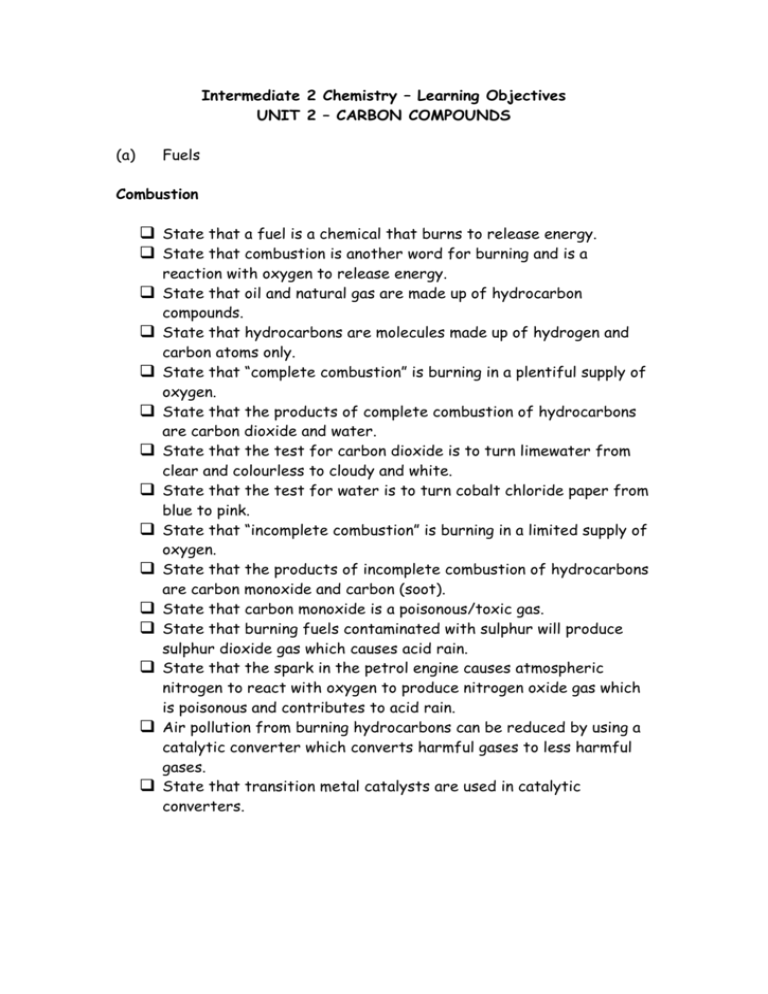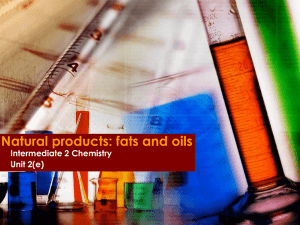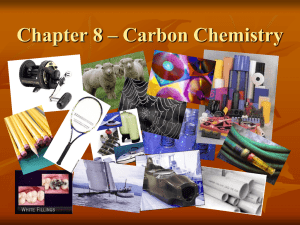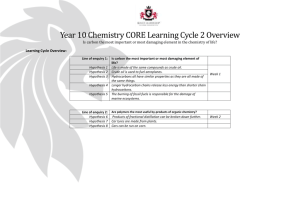Combustion - Anderson High School
advertisement

Intermediate 2 Chemistry – Learning Objectives UNIT 2 – CARBON COMPOUNDS (a) Fuels Combustion State that a fuel is a chemical that burns to release energy. State that combustion is another word for burning and is a reaction with oxygen to release energy. State that oil and natural gas are made up of hydrocarbon compounds. State that hydrocarbons are molecules made up of hydrogen and carbon atoms only. State that “complete combustion” is burning in a plentiful supply of oxygen. State that the products of complete combustion of hydrocarbons are carbon dioxide and water. State that the test for carbon dioxide is to turn limewater from clear and colourless to cloudy and white. State that the test for water is to turn cobalt chloride paper from blue to pink. State that “incomplete combustion” is burning in a limited supply of oxygen. State that the products of incomplete combustion of hydrocarbons are carbon monoxide and carbon (soot). State that carbon monoxide is a poisonous/toxic gas. State that burning fuels contaminated with sulphur will produce sulphur dioxide gas which causes acid rain. State that the spark in the petrol engine causes atmospheric nitrogen to react with oxygen to produce nitrogen oxide gas which is poisonous and contributes to acid rain. Air pollution from burning hydrocarbons can be reduced by using a catalytic converter which converts harmful gases to less harmful gases. State that transition metal catalysts are used in catalytic converters. Fractional distillation State that crude oil is a mixture of chemical compounds mainly (b) hydrocarbons. State that fractional distillation is a process used to separate crude oil into fractions based on the differences in boiling point. State that a fraction is a group of hydrocarbons of similar size and therefore similar boiling point. Relate the following properties to increasing molecular size of the molecules within the fractions; volatility, viscosity, flammability, boiling point range, colour. Relate the uses of hydrocarbon fractions to their properties. Nomenclature and structural formulae Hydrocarbons State that a homologous series is a series of compounds with the same general formula and similar chemical properties. Recognise the alkanes as a subset of hydrocarbons which have the general formula CnH2n+2 and are named with an –ane ending. Name and/or draw molecular formula, shortened structural formula or full structural formula for alkanes with between 1 and 8 carbons in the molecule. Systematically name (from shortened or full structural formula) branched chain alkanes with between 4 and 8 carbon atoms in the molecule. Recognise the alkenes as a subset of hydrocarbons which have at least one carbon to carbon double bond in the molecule and have the general formula CnH2n and are named with an –ene ending. Systematically name and/or draw shortened or full structural formulae, including the position of the double bond, for straight chain alkenes with between 2 and 8 carbon atoms in the molecule. Recognise the cycloalkanes as a subset of hydrocarbons which have the carbons joined in a ring and have the general formula CnH2n. Name and draw shortened and full structural formula for the cycloalkanes with between 3 and 8 carbons atoms in the molecule. Isomers State that isomers are molecules with the same molecular formula but different structural formula. Draw isomers for any given molecular, full or shortened structural formula. Alkanols and alkanoic acids Identify an alcohol by the presence of the hydroxyl –OH group in its structure and the “–ol” ending of its name. Name and draw structure for straight chain alcohols, including the position of the hydroxyl group, for molecules with between 1 and 8 carbon atoms in the chain. Identify an alkanoic acid from the presence of the carboxyl – COOH group in its structure and the “–oic” acid ending of its name. Name and draw structure for straight chain alkanoic acids for molecules with between 1 and 8 carbon atoms in the chain. Esters Identify and ester by the presence of the ester link –COO- in its structure and the “-oate” ending of its name. Name an ester given the name of the alcohol and alkanoic acid that it was made from. Name and draw full and shortened structural formula for an ester. Name the alcohol and alkanoic acid produced from the breakdown of a named ester or given structure. (c) Reactions of carbon compounds Addition reactions Explain that alkanes and cycloalkanes are called saturated hydrocarbons because they contain all carbon to carbon single bonds. Explain that alkenes are called unsaturated hydrocarbons because they contain at least one carbon to carbon double bond. State that bromine solution can be used to distinguish between saturated and unsaturated hydrocarbons. Explain that bromine water is decolourised because it undergoes an addition reaction across the carbon to carbon double bond. Use structure to explain that an alkene can be converted to an alkane by an addition reaction with hydrogen. Use structure to explain that an alkene can be converted to an alcohol by an addition reaction with water. Cracking State that fractional distillation of crude oil produces a high supply of less useful long chain hydrocarbons but only a low supply of more useful short chain hydrocarbons. State that cracking is an industrial process which breaks up long chain hydrocarbons into a mixture of smaller more useful molecules, some of which will be unsaturated. Explain that cracking produces some unsaturated molecules because there is not enough hydrogen atoms to produce all saturated molecules. State that a catalyst is used in cracking to allow the reaction to take place at lower temperatures. State that the catalyst used for the cracking process is aluminium oxide or silicate. Ethanol State that ethanol is the alcohol which is used commercially to make alcoholic drinks. State that ethanol is made from the fermentation reaction of glucose sugar which is obtained from plants (fruits and/or vegetables.) State that fermentation is carried out by yeast and is catalysed by enzymes found in yeast. Explain that there is a limit to the concentration of alcohol produced by fermentation because yeast is a living organism and will only convert sugar to alcohol until the concentration reaches a level which is toxic to the yeast. State that alcohol concentration is increased by the process of distillation for the manufacture of “spirit” drinks. Describe the effects on the mind and body of different levels of alcohol consumption. State that to meet market demands, alcohol is also produced by the addition of water to ethane and that this process is called catalytic hydration. State that ethanol can be converted to ethene by a reaction called catalytic dehydration. State that ethanol can be mixed with petrol to use as a fuel for cars. Explain that ethanol is a renewable fuel because it can be continuously produced by the fermentation of sugar cane. Making and breaking esters State that esters are made by a condensation reaction between an alcohol and a carboxylic acid. Show using structure that in a condensation reaction, water is produced from the hydrogen of the hydroxyl group and the –OH of the carboxyl group. State that esters are broken by a hydrolysis reaction to produce and alcohol and a carboxylic acid. Show in a word or structural equation that making and breaking esters is a reversible process. (d) Plastics and synthetic fibres Uses State that synthetic materials are those made by the chemical industry. State that most synthetic materials are derived from oil. Explain the advantages and disadvantages of synthetic materials when compared to natural materials. Give examples of plastics and relate their uses to their properties. State that Kevlar is a recently developed plastic which is very strong. State that polyethanol is a recently developed plastic which is soluble in water. State that biopol is a recently developed plastic which will break down naturally. Explain that a biodegradable substance is one which breaks down naturally by the action of microorganisms. Explain that plastics lead to litter problems due to the fact that most plastics are non biodegradeable. State that plastics burn to release toxic gases. State that all plastics burn to release carbon monoxide. State that plastics containing chlorine (eg PVC) will burn to release hydrogen chloride. State that plastics containing nitrogen (eg polyurethane) will burn to release hydrogen cyanide. State that a thermoplastic plastic is one which softens on heating and can be reshaped. State that a thermosetting plastic is one which does not soften on heating. Polymerisation Plastics are made up of long chain molecules called “polymers” which means ‘many units’. Polymers are made up from many small molecules called “monomers” which means ‘single unit’. Addition polymerisation State that addition polymers are made from addition reactions between the monomers across the reactive carbon to carbon double bond. State that the small unsaturated monomer molecules are obtained by cracking fractions from crude oil. Name polymers from the name of the monomer and vice versa. Draw monomer structure, repeating unit structure and sections of a polymer chain. Condensation polymerisation State that condensation polymers are made from condensation reactions between monomers with two functional groups on the molecule. State that polyesters are made from diacids (two carboxyl groups on the molecule) and diols (two hydroxyl groups on the molecule). State that polyamides are made from diacids (two carboxyl groups on the molecule) and diamines (two amine groups on the molecule). Identify an amide link produced by the reaction of an amine and an acid. Draw the monomer, repeating unit and polymer structures for a condensation polymer. (e) Natural products Carbohydrates State that carbohydrates are an important class of food made by plants. State that carbohydrates supply the body with energy. State that carbohydrates are made up of carbon atoms, hydrogen atoms and oxygen atoms in a ratio of 1:2:1. Classify carbohydrates as polymers (starch) or monomers (sugars). Give examples of sugars including glucose, fructose, maltose and sucrose. State that with the exception of sucrose, the above sugars give a colour change of blue to orange when heated with benedict’s solution. State that starch gives a colour change of brown to black when mixed with iodine solution. State that glucose is produced by photosynthesis and is converted to starch for storage by condensation polymerisation. State that when starch is digested, acid and enzymes in the body hydrolyse the starch molecule to sugar molecules. Proteins State that proteins are an important class of food made by plants. State that structural proteins are required as building materials in animals bodies for growth and repair of body tissues. State that functional proteins such as hormones and enzymes are required to regulate processes in the body. State that proteins are polymers made from condensation reactions between amino acid monomers. Recognise the amide link in proteins and that proteins are also called polyamides and polypeptides. Draw the monomer, repeating unit and polymer structure of a protein. State that during digestion, enzymes and acid hydrolyse protein molecules to amino acid monomers. Fats and Oils Classify natural fats and oils as being animal, vegetable or marine in origin. Explain that fats have a higher melting point than oils because fats are saturated (single bonds) and therefore the molecules can pack more tightly together. Explain that oils can be hardened (made solid) by removing some of the unsaturation (double bonds) by addition of hydrogen (hydrogenation). State that fats and oils are a more concentrated source of energy than carbohydrates. State that fats and oils are esters. State that the alcohol used to make fats and oils is called glycerol and draw its structure. State that the acids used to make fats and oils are fatty acids which are long chain carboxylic acids. Explain that hydrolysis of fats and oils produces 3 fatty acids for every glycerol because glycerol is a triol (three alcohol groups). Explain that fats and oils are triesters (three ester links) because they are made from glycerol which is a triol.







